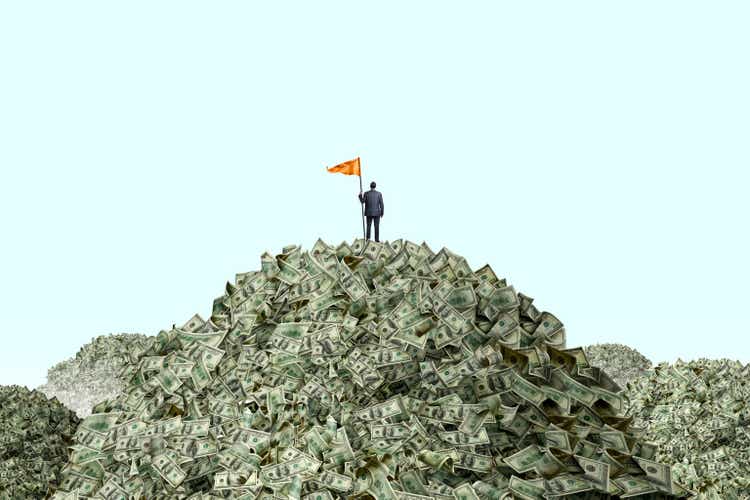There Is Lots Of Money Around Private Credit

Summary
- Financial markets still have available money despite the Federal Reserve's tightened monetary policy.
- Private credit funds are just another example of a sector of the financial world that took advantage of all the funds the Federal Reserve created in the recent past.
- However, there are still lots and lots of money around that is being used to keep investment-grade companies going for a fairly long time.
DNY59
Recently, I have been writing a lot about all the money that is still available in the financial markets, even though the Federal Reserve has been tightening up on monetary policy for 15 months or so.
First, "Private credit has boomed in the decade since the global financial crisis…"
In the past, loans from private credit have gone into companies that were smaller or riskier.
But, times have changed.
Eric Platt tells us that "Alternative asset managers such as Apollo, KKR, and Blackstone are increasingly financing blue-chip companies, as businesses look for new sources of capital to help counteract the effects of higher interest and a slowing economy."
The growing reach of the private credit industry helps companies bypass traditional banks and bond markets to raise money.
Thank you, Federal Reserve.
"Private credit is going investment grade."
Over the past 10 years or so, private credit has seen financial markets grow heavy with funds, and it has decided to take advantage of the availability of money.
I have written about the asset bubble the Federal Reserve created with three rounds of quantitative easing during the period the economy was recovering from the Great Recession and then one more round, one excessively generous, as the Fed worked to prevent a financial collapse resulting from the Covid-19 pandemic spread.
I have written many articles about where these funds found a resting place, like in the world of "blank check financing," and the world of cryptocurrencies.
I have written about how these funds found a resting place in other nooks of the financial market.
And, I have written about how these funds found a resting place in the "excess reserves" of the commercial banking system.
Overall, trillions of dollars were injected into the U.S. financial system in the past five to ten years, and the private credit sector bloomed into a total of $1.4 trillion in assets. Not a bad sum to "play around" with.
Furthermore, private credit funds have found ways to multiply this into even more assets to work with.
As Mr. Platt writes, "Private equity groups have bought or invested in an insurance company in the past five years, drawing in hundreds of billions of premiums to invest."
Marc Rowan, chief executive officer of Apollo, states,
"We made a bet on private investment grade."
"We are also a beneficiary of this de-banking of the world because the assets that we need… were the kinds of things that used to go on the balance sheets of banks, investment-grade private credit."
And, the insurance units that the funds acquired are required by state regulators to invest "the vast majority of their holdings in investment-grade rated debt, to safeguard policyholders."
Clever.
So, the beat goes on.
And, this is just another reason why the Federal Reserve… and other central banks around the world… are finding it so difficult to "tighten up" on their financial systems.
Trillions of dollars of cash have been created by the Federal Reserve over the past 10 years or so and there is still a vast amount of these monies still "hanging around" the financial system, waiting to be lent out to keep the market in investment grade private credit vibrant.
And this is what the Federal Reserve must overcome in order to defeat inflation.
This is why the investment community has doubts about the Federal Reserve really accomplishing its goal. The objectives of the Federal Reserve just do not seem to be substantial enough to remove all the "credit" that has been created or that can be created in the economy.
That is, in creating the asset bubble, the Federal Reserve pumped a huge amount of money into the financial system.
Now, we are on the other side of the bubble. And, there is a lot of work for the Fed to do.
Furthermore, there are still more "segments" of the financial system, like the private credit segment, to be identified and discussed.
The consequences of creating asset bubbles tend to last for a long time.
This article was written by
Analyst’s Disclosure: I/we have no stock, option or similar derivative position in any of the companies mentioned, and no plans to initiate any such positions within the next 72 hours. I wrote this article myself, and it expresses my own opinions. I am not receiving compensation for it (other than from Seeking Alpha). I have no business relationship with any company whose stock is mentioned in this article.
Seeking Alpha's Disclosure: Past performance is no guarantee of future results. No recommendation or advice is being given as to whether any investment is suitable for a particular investor. Any views or opinions expressed above may not reflect those of Seeking Alpha as a whole. Seeking Alpha is not a licensed securities dealer, broker or US investment adviser or investment bank. Our analysts are third party authors that include both professional investors and individual investors who may not be licensed or certified by any institute or regulatory body.
